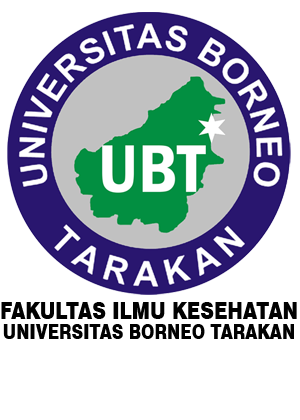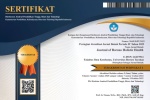Penerapan Terapi Cermin Untuk Meningkatkan Kekuatan Otot Pada Pasien Stroke Non Hemoragik
Abstract
Keywords
Full Text:
PDF (Bahasa Indonesia)References
Andarwati, A., Widodo, A., & Setiyawati, W. (2013). Pengaruh Latihan ROM terhadap Peningkatan Kekuatan Otot Pasien Hemiparese RSUD dr Moewardi Surakarta.
Curran, V., Hollett, A., Casimiro, L. M., McCarthy, P., Banfield, V., Hall, P., Lackie, K., Oandasan, I., Simmons, B., & Wagner, S. (2011). Development and validation of the interprofessional collaborator assessment rubric (ICAR). Journal of Interprofessional Care, 25(5), 339–344. https://doi.org/10.3109/13561820.2011.589542
Kakuda, W., Abo, M., Shimizu, M., Sasanuma, J., Okamoto, T., Yokoi, A., Taguchi, K., Mitani, S., Harashima, H., Urushidani, N., Urashima, M., & Investigators, T. N. (2012). A multi-center study on low-frequency rTMS combined with intensive occupational therapy for upper limb hemiparesis in post-stroke patients. Journal of NeuroEngineering and Rehabilitation, 9(1), 4. https://doi.org/10.1186/1743-0003-9-4
Lee, M. M., Cho, H., & Song, C. H. (2012). The Mirror Therapy Program Enhances Upper-Limb Motor Recovery and Motor Function in Acute Stroke Patients. American Journal of Physical Medicine & Rehabilitation, 91(8). https://journals.lww.com/ajpmr/Fulltext/2012/08000/The_Mirror_Therapy_Program_Enhances_Upper_Limb.8.aspx
Michielsen, M. E., Selles, R. W., van der Geest, J. N., Eckhardt, M., Yavuzer, G., Stam, H. J., Smits, M., Ribbers, G. M., & Bussmann, J. B. J. (2010). Motor Recovery and Cortical Reorganization After Mirror Therapy in Chronic Stroke Patients: A Phase II Randomized Controlled Trial. Neurorehabilitation and Neural Repair, 25(3), 223–233. https://doi.org/10.1177/1545968310385127
Mirela Cristina, L., Matei, D., Ignat, B., & Popescu, C. D. (2015). Mirror therapy enhances upper extremity motor recovery in stroke patients. Acta Neurologica Belgica, 115(4), 597–603. https://doi.org/10.1007/s13760-015-0465-5
Okazaki, H., Beppu, H., Mizutani, K., Okamoto, S., & Sonoda, S. (2014). Changes in Serum Growth Factors in Stroke Rehabilitation Patients and Their Relation to Hemiparesis Improvement. Journal of Stroke and Cerebrovascular Diseases, 23(6), 1703–1708. https://doi.org/https://doi.org/10.1016/j.jstrokecerebrovasdis.2014.01.015
Pervane Vural, S., Nakipoglu Yuzer, G. F., Sezgin Ozcan, D., Demir Ozbudak, S., & Ozgirgin, N. (2016). Effects of Mirror Therapy in Stroke Patients With Complex Regional Pain Syndrome Type 1: A Randomized Controlled Study. Archives of Physical Medicine and Rehabilitation, 97(4), 575–581. https://doi.org/https://doi.org/10.1016/j.apmr.2015.12.008
Rahmadani, E., & Rustandi, H. (2019). Peningkatan Kekuatan Otot Pasien Stroke Non Hemoragik dengan Hemiparese melalui Latihan Range of Motion Pasif. Journal of Telenursing, 1(2), 354–363.
Rothgangel, A. S., Braun, S. M., Beurskens, A. J., Seitz, R. J., & Wade, D. T. (2011). The clinical aspects of mirror therapy in rehabilitation: a systematic review of the literature. International Journal of Rehabilitation Research, 34(1). https://journals.lww.com/intjrehabilres/Fulltext/2011/03000/The_clinical_aspects_of_mirror_therapy_in.1.aspx
Selles, R. W., Michielsen, M. E., Bussmann, J. B. J., Stam, H. J., Hurkmans, H. L., Heijnen, I., de Groot, D., & Ribbers, G. M. (2014). Effects of a Mirror-Induced Visual Illusion on a Reaching Task in Stroke Patients: Implications for Mirror Therapy Training. Neurorehabilitation and Neural Repair, 28(7), 652–659. https://doi.org/10.1177/1545968314521005
Stoykov, M. E., Lewis, G. N., & Corcos, D. M. (2009). Comparison of Bilateral and Unilateral Training for Upper Extremity Hemiparesis in Stroke. Neurorehabilitation and Neural Repair, 23(9), 945–953. https://doi.org/10.1177/1545968309338190
Thieme, H., Mehrholz, J., Pohl, M., Behrens, J., & Dohle, C. (2013). Mirror Therapy for Improving Motor Function After Stroke. Stroke, 44(1), e1–e2. https://doi.org/10.1161/STROKEAHA.112.673087
Wakhidah, N., Asyrofi, A., & Prasetya, H. (2019). Perbedaan Latihan Kekuatan Otot Pasien Pasca Stroke yang Memperoleh Berbagai Dukungan Keluarga. Jurnal Ilmiah Permas, 9(3), 249–258.
Wheaton, L. A., Villagra, F., Hanley, D. F., Macko, R. F., & Forrester, L. W. (2009). Reliability of TMS motor evoked potentials in quadriceps of subjects with chronic hemiparesis after stroke. Journal of the Neurological Sciences, 276(1), 115–117. https://doi.org/https://doi.org/10.1016/j.jns.2008.09.012
Wist, S., Clivaz, J., & Sattelmayer, M. (2016). Muscle strengthening for hemiparesis after stroke: A meta-analysis. Annals of Physical and Rehabilitation Medicine, 59(2), 114–124. https://doi.org/https://doi.org/10.1016/j.rehab.2016.02.001
Wu, C.-Y., Huang, P.-C., Chen, Y.-T., Lin, K.-C., & Yang, H.-W. (2013). Effects of Mirror Therapy on Motor and Sensory Recovery in Chronic Stroke: A Randomized Controlled Trial. Archives of Physical Medicine and Rehabilitation, 94(6), 1023–1030. https://doi.org/https://doi.org/10.1016/j.apmr.2013.02.007
Yavuzer, G., Selles, R., Sezer, N., Sütbeyaz, S., Bussmann, J. B., Köseoğlu, F., Atay, M. B., & Stam, H. J. (2008). Mirror Therapy Improves Hand Function in Subacute Stroke: A Randomized Controlled Trial. Archives of Physical Medicine and Rehabilitation, 89(3), 393–398. https://doi.org/https://doi.org/10.1016/j.apmr.2007.08.162
Yun, G. J., Chun, M. H., Park, J. Y., & Kim, B. R. (2011). The synergic effects of mirror therapy and neuromuscular electrical stimulation for hand function in stroke patients. Annals of Rehabilitation Medicine, 35(3), 316–321. https://doi.org/10.5535/arm.2011.35.3.316
DOI: https://doi.org/10.35334/borticalth.v4i2.2263
Refbacks
- There are currently no refbacks.









